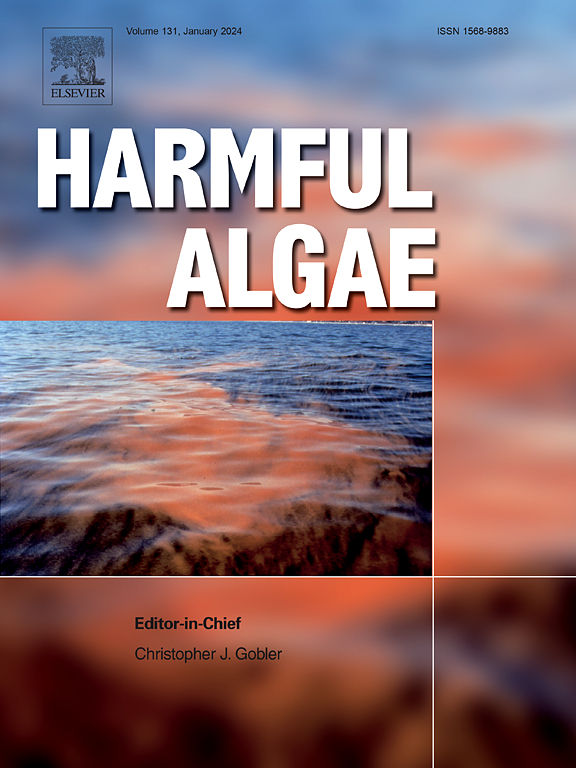First description of the fish-killing raphidophyceae Chattonella marina complex in Argentina: From genetics to ichthyotoxicity unveiled
IF 5.5
1区 生物学
Q1 MARINE & FRESHWATER BIOLOGY
引用次数: 0
Abstract
Species of the harmful algal bloom (HAB)-forming genus Chattonella (Raphidophyceae) are responsible for massive fish kills worldwide. Despite this, the genus remains still unexplored in Argentinean waters in the Southwestern Atlantic. Three Chattonella strains (LPCc045, LPCc046, and LPCc047) were isolated and cultured as part of a harmful phytoplankton monitoring program in the marine coastal waters of Buenos Aires Province to determine: 1) taxonomic and genetic identification, 2) pigment compositions, and 3) ichthyotoxic potency and ROS production. Morphological observations (light and transmission electron microscopy) matched classical descriptions of C. marina. Phylogenetic reconstruction using a partial sequence of the ribosomal gene (LSU D1-D2) confirmed the cluster of the three strains within the C. marina complex clade (99 % bootstrap support). Pigment analyses by HPLC showed that the most abundant was chlorophyll-a, followed by fucoxanthin and other carotenoids. Gill cell damage, used as a proxy of cytotoxicity, was assessed using the rainbow trout RTgill-W1 cell-based assay against cell supernatant and intracellular treatments. Cytotoxic potency was positively correlated with cell abundance, with supernatant treatment causing more gill cell damage than intracellular content, reducing gill cell viability down to 60 % of control at 1.9 × 103 cells mL-1. Superoxide production was comparable with other globally distributed strains (supernatant 7.63 ± 0.67 pmol O2- cell-1 h-1; intracellular 8.1 ± 0.56 pmol O2- cell-1 h-1). This study provides the first morphological, phylogenetic, physiological and toxicological characterization of the fish-killing algae C. marina complex in Argentinean waters.
首次描述阿根廷的杀鱼raphidophyceae chatonella marina复合体:从遗传学到鱼毒性揭晓
有害藻华(HAB)形成属Chattonella (Raphidophyceae)的物种是造成世界范围内大量鱼类死亡的原因。尽管如此,该属在西南大西洋的阿根廷水域仍未被发现。本文在阿根廷布宜诺斯艾利亚省沿海海域对三株查顿菌(lpc045、lpc046和lpc047)进行了分离培养,并对其分类和遗传鉴定、色素组成和鱼毒性及活性氧的产生进行了研究。形态学观察(光镜和透射电镜)与经典描述相符。利用核糖体基因(LSU D1-D2)的部分序列进行系统发育重建,证实了这3株菌株属于C. marina复合体分支(99% bootstrap支持)。高效液相色谱法分析表明,其色素含量最高的是叶绿素-a,其次是岩藻黄质和其他类胡萝卜素。使用虹鳟鱼RTgill-W1细胞为基础的细胞上清和细胞内处理试验评估鳃细胞损伤,作为细胞毒性的代理。细胞毒性效力与细胞丰度呈正相关,与细胞内含量相比,上清液处理造成的鳃细胞损伤更大,在1.9 × 103个细胞mL-1时,鳃细胞活力降低至对照的60%。超氧化物产量与其他全球分布菌株相当(上清为7.63±0.67 pmol O2- cell-1 h-1;细胞内8.1±0.56 pmol O2- cell-1 h-1)。本研究首次对阿根廷水域的杀鱼藻类C. marina复合体进行了形态学、系统发育、生理学和毒理学表征。
本文章由计算机程序翻译,如有差异,请以英文原文为准。
求助全文
约1分钟内获得全文
求助全文
来源期刊

Harmful Algae
生物-海洋与淡水生物学
CiteScore
12.50
自引率
15.20%
发文量
122
审稿时长
7.5 months
期刊介绍:
This journal provides a forum to promote knowledge of harmful microalgae and macroalgae, including cyanobacteria, as well as monitoring, management and control of these organisms.
 求助内容:
求助内容: 应助结果提醒方式:
应助结果提醒方式:


